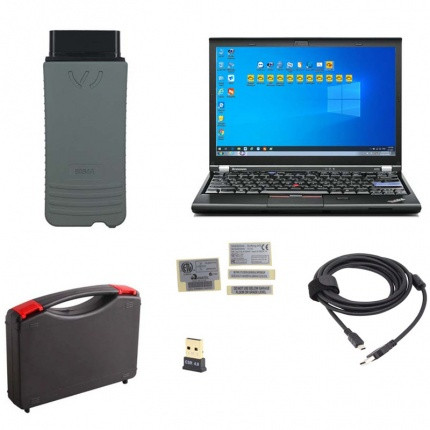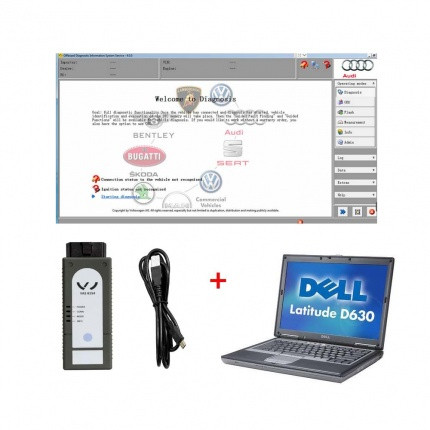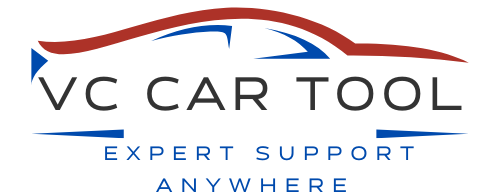VAS5054A vs VAS6154: Decoding the Best Diagnostic Tool for Your Garage
Navigating the world of automotive diagnostics can be challenging, especially when choosing the right tools for your workshop. This comprehensive comparison of VAS5054A and VAS6154, two popular diagnostic tools, provides a detailed analysis of their features, functionalities, and suitability for different needs, ensuring you make an informed decision for your business. By understanding the strengths and weaknesses of each device, you can optimize your diagnostic processes, improve efficiency, and provide superior service to your clients. Discover the key differences, pros, and cons to make an informed choice.
1. Understanding the Basics: VAS5054A and VAS6154 Defined
The VAS5054A and VAS6154 are diagnostic tools primarily used for Volkswagen, Audi, Skoda, and SEAT vehicles. These tools allow technicians to perform a range of functions, including reading and clearing diagnostic trouble codes (DTCs), accessing live data, performing component testing, and programming control units. Choosing the right tool depends on your specific needs, budget, and the types of vehicles you service. Let’s delve into what makes each tool unique.
1.1. What is VAS5054A?
The VAS5054A is a diagnostic interface that connects to vehicles via USB or Bluetooth. It supports older protocols and is widely used for vehicles manufactured before 2018. This tool is known for its reliability and compatibility with a broad range of diagnostic software. Many technicians favor the VAS5054A for its robust performance and cost-effectiveness.
1.2. What is VAS6154?
The VAS6154 is the newer diagnostic interface, designed to support the latest vehicle models and diagnostic protocols, including DoIP (Diagnostics over Internet Protocol). It communicates via USB or WLAN (Wireless Local Area Network) and is better suited for newer vehicles requiring faster data transfer rates and advanced diagnostic capabilities. While it offers advanced features, it may come at a higher price point.
2. Key Differences Between VAS5054A and VAS6154
Understanding the differences between the VAS5054A and VAS6154 is crucial for making the right choice. Here’s a detailed comparison of their communication methods, vehicle compatibility, hardware, and software capabilities.
2.1. Communication Interface
- VAS5054A: Supports both USB and Bluetooth connectivity. Bluetooth offers wireless convenience, while USB provides a stable, wired connection.
- VAS6154: Uses USB and WLAN for communication. WLAN offers faster and more reliable wireless connectivity compared to Bluetooth, essential for handling large data volumes in newer vehicles.
2.2. Vehicle Compatibility
- VAS5054A: Compatible with VW, Audi, Skoda, and SEAT vehicles, particularly those manufactured before 2018. It also supports older protocols required for diagnosing older models.
- VAS6154: Designed for newer vehicles and supports the latest diagnostic protocols, including DoIP. It ensures compatibility with future car models, making it a forward-looking investment.
2.3. Hardware and Firmware
- VAS5054A: Utilizes older hardware, which is reliable but may lack the processing power for newer diagnostic tasks. The firmware is stable and well-tested.
- VAS6154: Features upgraded hardware for faster data processing and more reliable performance with newer vehicles. The firmware is designed to support advanced diagnostic functions and protocols.
2.4. Software Compatibility
- VAS5054A: Works with older versions of ODIS (Offboard Diagnostic Information System) software. While it can perform many diagnostic functions, it may not support the latest software features.
- VAS6154: Compatible with the latest ODIS software versions, allowing access to advanced diagnostic functions, online programming, and vehicle diagnostics.
2.5. Protocol Support
- VAS5054A: Supports standard diagnostic protocols like K-Line, CAN, and UDS.
- VAS6154: Supports all the protocols of VAS5054A, plus the advanced DoIP (Diagnostics over Internet Protocol), which is essential for diagnosing and programming newer vehicles with Ethernet-based communication systems.
3. Detailed Comparison Table: VAS5054A vs. VAS6154
To provide a clearer comparison, here’s a table summarizing the key differences between the VAS5054A and VAS6154:
| Feature | VAS5054A | VAS6154 |
|---|---|---|
| Communication | USB, Bluetooth | USB, WLAN |
| Vehicle Compatibility | Older Models (Pre-2018) | Newer Models (Including DoIP) |
| Hardware | Older | Upgraded |
| Software | Older ODIS Versions | Latest ODIS Versions |
| Protocol Support | K-Line, CAN, UDS | K-Line, CAN, UDS, DoIP |
| Price | Generally Lower | Generally Higher |
| Use Case | Basic Diagnostics, Older Vehicles | Advanced Diagnostics, Newer Vehicles |
4. Pros and Cons of Each Tool
Weighing the advantages and disadvantages of each tool will help you determine which one best fits your needs.
4.1. VAS5054A: Advantages
- Cost-Effective: Generally more affordable than the VAS6154.
- Reliable: Proven track record with older vehicles and diagnostic software.
- Bluetooth Connectivity: Offers wireless convenience for increased mobility in the workshop.
4.2. VAS5054A: Disadvantages
- Limited Compatibility: Not suitable for newer vehicles using advanced protocols like DoIP.
- Slower Data Transfer: Bluetooth and older hardware may result in slower data transfer rates.
- Software Limitations: May not support the latest ODIS software features.
4.3. VAS6154: Advantages
- Future-Proof: Supports the latest diagnostic protocols, including DoIP, ensuring compatibility with future car models.
- Faster Data Transfer: WLAN connectivity and upgraded hardware provide faster and more reliable data transfer rates.
- Advanced Features: Compatible with the latest ODIS software versions, unlocking advanced diagnostic capabilities.
4.4. VAS6154: Disadvantages
- Higher Cost: Generally more expensive than the VAS5054A.
- WLAN Dependency: Requires a stable WLAN connection for optimal performance.
- Complexity: Advanced features may require additional training and expertise.
5. Real-World Applications: Which Tool for Which Scenario?
To illustrate the practical applications of each tool, let’s consider a few scenarios:
5.1. Scenario 1: Servicing Older Vehicles (Pre-2018)
If your workshop primarily services older VW, Audi, Skoda, and SEAT vehicles, the VAS5054A is a cost-effective and reliable choice. It supports the necessary protocols and diagnostic functions for these models, providing excellent value for your investment.
5.2. Scenario 2: Servicing Newer Vehicles (Post-2018)
For workshops dealing with newer vehicles equipped with advanced systems and DoIP, the VAS6154 is essential. It ensures compatibility with the latest technologies and provides the necessary bandwidth for fast and reliable diagnostics.
5.3. Scenario 3: A Mixed Fleet of Vehicles
If your workshop services a mix of older and newer vehicles, consider investing in both tools. The VAS5054A can handle older models, while the VAS6154 covers the newer ones, providing comprehensive diagnostic coverage for your entire fleet.
6. The Clone Dilemma: Are Clone Devices Worth the Risk?
When considering VAS5054A and VAS6154, you might encounter clone devices. While they may seem like a budget-friendly option, it’s crucial to understand the risks involved.
6.1. Potential Issues with Clones:
- Unreliable Performance: Clone devices often have inferior components, leading to inconsistent and unreliable performance.
- Software Compatibility Problems: They may not be fully compatible with the latest ODIS software, limiting functionality.
- Firmware Issues: Flashing firmware on clone devices can be risky, potentially bricking the device.
- Lack of Support: Clone devices typically come with no warranty or technical support, leaving you on your own if issues arise.
- Security Risks: Using clone devices can expose your network to security vulnerabilities, potentially compromising sensitive data.
6.2. Official vs. Clone: A Side-by-Side Comparison
| Feature | Official VAS5054A/6154 | Clone VAS5054A/6154 |
|---|---|---|
| Performance | Reliable and consistent | Unreliable and inconsistent |
| Software Support | Full compatibility | Limited compatibility |
| Firmware | Stable and upgradable | Risky to flash |
| Warranty | Yes | No |
| Technical Support | Yes | No |
| Security | Secure | Potential vulnerabilities |
Instead of risking your business with unreliable clones, consider investing in genuine tools from reputable suppliers. VCCarTool offers high-quality diagnostic tools and expert support to ensure your workshop runs smoothly and efficiently. Contact VCCarTool now via WhatsApp: +1 (901) 414 – 1927 to discuss your diagnostic needs and find the best solutions.
7. How to Choose the Right Tool for Your Workshop
Selecting the right diagnostic tool requires careful consideration of your workshop’s specific needs. Here are some factors to consider:
7.1. Assess Your Vehicle Servicing Needs
- Types of Vehicles: Determine the types of vehicles you service most frequently. If you primarily work on older models, the VAS5054A may suffice. For newer vehicles, the VAS6154 is essential.
- Diagnostic Requirements: Identify the diagnostic functions you need to perform regularly. Basic diagnostics can be handled by the VAS5054A, while advanced functions require the VAS6154.
7.2. Consider Your Budget
- Initial Investment: Factor in the initial cost of the diagnostic tool. The VAS6154 typically comes with a higher price tag than the VAS5054A.
- Long-Term Costs: Consider long-term costs such as software updates, maintenance, and potential repairs.
7.3. Evaluate Software and Support
- Software Compatibility: Ensure the tool is compatible with the software you use in your workshop. The VAS6154 is designed to work with the latest ODIS versions.
- Technical Support: Choose a supplier that offers reliable technical support and training. VCCarTool provides expert support to help you get the most out of your diagnostic tools. Don’t hesitate to contact us via WhatsApp: +1 (901) 414 – 1927 or email [email protected] for any assistance.
7.4. Read User Reviews and Seek Recommendations
- Online Reviews: Look for online reviews and testimonials from other technicians who have used the tools.
- Industry Forums: Participate in industry forums and ask for recommendations from experienced professionals.
8. Setting Up and Using Your Diagnostic Tool
Once you’ve chosen the right diagnostic tool, proper setup and usage are essential for optimal performance. Here are some tips to get you started:
8.1. Software Installation
- Follow Instructions: Carefully follow the software installation instructions provided by the manufacturer.
- Update Regularly: Keep your software updated to ensure compatibility and access to the latest features.
8.2. Connecting to the Vehicle
- Proper Connection: Ensure a secure and proper connection between the diagnostic tool and the vehicle’s OBD-II port.
- Stable Power Supply: Maintain a stable power supply to prevent interruptions during diagnostic procedures.
8.3. Basic Diagnostic Procedures
- Read DTCs: Start by reading diagnostic trouble codes (DTCs) to identify potential issues.
- Live Data: Access live data to monitor vehicle parameters in real-time.
- Component Testing: Perform component testing to verify the functionality of individual components.
9. Advanced Diagnostic Techniques
To leverage the full potential of your diagnostic tool, consider mastering advanced techniques such as:
9.1. ECU Programming
- Online Access: Utilize online access for ECU programming and software updates.
- Backup Data: Always back up existing data before performing any programming procedures.
9.2. Key Programming
- Security Measures: Follow security protocols when programming keys to prevent unauthorized access.
- Proper Tools: Use the correct tools and software for key programming.
9.3. Adaptation and Calibration
- Component Adaptation: Perform component adaptation to ensure proper integration of new components.
- Sensor Calibration: Calibrate sensors to maintain accurate readings and optimal performance.
10. Maintenance and Care for Longevity
To ensure your diagnostic tool lasts for years, proper maintenance and care are essential.
10.1. Regular Cleaning
- Keep Clean: Keep the tool clean and free from dust and debris.
- Proper Storage: Store the tool in a dry and safe place when not in use.
10.2. Cable Management
- Avoid Damage: Avoid bending or twisting cables excessively.
- Inspect Regularly: Inspect cables regularly for signs of wear and tear.
10.3. Software Updates
- Stay Updated: Keep the software updated to ensure compatibility and access to the latest features.
- Backup Data: Back up your data before performing any software updates.
 VAS 5054A With OKI Chip VAG Diagnostic Tool ODIS V7.1.1 Plus Lenovo X220 Laptop Ready to Use
VAS 5054A With OKI Chip VAG Diagnostic Tool ODIS V7.1.1 Plus Lenovo X220 Laptop Ready to Use
 Newest VAS 6154 VAG Diagnostic Tool ODIS V7.1.1 Replace VAS 5054 with Dell D630 Laptop 500G SSD Ready to Use
Newest VAS 6154 VAG Diagnostic Tool ODIS V7.1.1 Replace VAS 5054 with Dell D630 Laptop 500G SSD Ready to Use
11. Overcoming Common Diagnostic Challenges
Even with the best diagnostic tools, you may encounter challenges. Here are some tips for overcoming common issues:
11.1. Communication Errors
- Check Connections: Verify all connections between the tool and the vehicle.
- Software Compatibility: Ensure the software is compatible with the vehicle’s system.
11.2. Inaccurate Readings
- Calibrate Sensors: Calibrate sensors to ensure accurate readings.
- Check Wiring: Inspect wiring for damage or corrosion.
11.3. Software Glitches
- Restart Tool: Restart the diagnostic tool and software.
- Update Software: Update to the latest software version.
12. Future Trends in Automotive Diagnostics
The field of automotive diagnostics is constantly evolving. Here are some future trends to keep in mind:
12.1. Remote Diagnostics
- Telematics: Increased use of telematics for remote diagnostics and monitoring.
- Cloud-Based Solutions: Cloud-based diagnostic platforms for real-time data analysis and remote support.
12.2. Artificial Intelligence (AI)
- AI-Powered Diagnostics: AI-powered diagnostic tools that can predict and diagnose issues more accurately.
- Machine Learning: Machine learning algorithms that can learn from historical data to improve diagnostic accuracy.
12.3. Enhanced Cybersecurity
- Secure Communication: Enhanced cybersecurity measures to protect against unauthorized access and data breaches.
- Data Encryption: Data encryption to ensure the privacy and security of vehicle information.
13. The VCCarTool Advantage: Why Choose Us?
At VCCarTool, we understand the challenges faced by modern automotive workshops. That’s why we offer a comprehensive range of high-quality diagnostic tools, including the VAS5054A and VAS6154, along with expert support and training. Here’s why you should choose VCCarTool:
- Quality Products: We only offer genuine and reliable diagnostic tools from reputable manufacturers.
- Expert Support: Our team of experienced technicians provides expert support and training to help you get the most out of your tools. Contact us via WhatsApp: +1 (901) 414 – 1927 for immediate assistance.
- Competitive Pricing: We offer competitive pricing on all our products, ensuring you get the best value for your investment.
- Comprehensive Solutions: From diagnostic tools to software and accessories, we provide comprehensive solutions for all your automotive diagnostic needs.
- Customer Satisfaction: We are committed to customer satisfaction and strive to exceed your expectations with every purchase.
14. Call to Action: Upgrade Your Diagnostic Capabilities Today
Don’t let outdated diagnostic tools hold your workshop back. Upgrade to the latest VAS5054A or VAS6154 from VCCarTool and experience the difference. Improve efficiency, accuracy, and customer satisfaction with our high-quality diagnostic solutions.
Ready to take your workshop to the next level? Contact VCCarTool today:
- WhatsApp: +1 (901) 414 – 1927
- Email: [email protected]
- Website: vccartool.com
Let VCCarTool be your trusted partner in automotive diagnostics. We’re here to help you succeed.
15. FAQs: Addressing Your Queries on VAS5054A and VAS6154
15.1. What is the main difference between VAS5054A and VAS6154?
The main difference lies in their compatibility and communication methods. VAS5054A is better suited for older vehicles and uses Bluetooth, while VAS6154 is designed for newer vehicles with DoIP and uses WLAN.
15.2. Which tool is better for diagnosing newer VW models?
VAS6154 is the better choice for diagnosing newer VW models, as it supports the latest diagnostic protocols and technologies like DoIP.
15.3. Can I use VAS5054A for online programming?
VAS5054A can be used for some online programming tasks, but VAS6154 is recommended for newer vehicles requiring advanced programming capabilities.
15.4. Is VAS6154 compatible with older vehicles?
While VAS6154 is primarily designed for newer vehicles, it can still work with some older models. However, VAS5054A is generally more reliable for older vehicles.
15.5. Are clone versions of these tools reliable?
Clone versions are often unreliable and may not be fully compatible with software updates. It’s best to invest in genuine tools for consistent performance.
15.6. What software is required for VAS5054A and VAS6154?
Both tools require ODIS (Offboard Diagnostic Information System) software, but VAS6154 is designed to work with the latest versions of ODIS.
15.7. How do I update the firmware on VAS5054A and VAS6154?
Firmware updates should be performed through the ODIS software. Always follow the manufacturer’s instructions to avoid damaging the device.
15.8. Which tool offers faster data transfer rates?
VAS6154 offers faster data transfer rates due to its WLAN connectivity and upgraded hardware.
15.9. Where can I buy genuine VAS5054A and VAS6154 tools?
You can purchase genuine tools from reputable suppliers like VCCarTool. Contact us via WhatsApp: +1 (901) 414 – 1927 or visit our website vccartool.com for more information.
15.10. What kind of technical support does VCCarTool provide?
VCCarTool offers expert technical support and training to help you get the most out of your diagnostic tools. Contact us via WhatsApp: +1 (901) 414 – 1927 or email [email protected] for any assistance.

